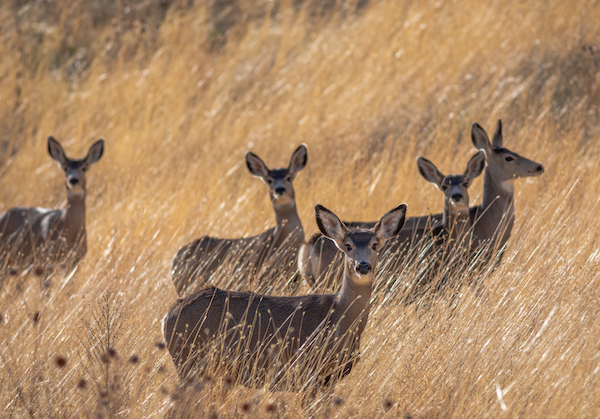
2022 WA Deer, Elk, Bighorn Special Permit Tweaks Proposed
Washington hunting managers are proposing a quadruple-digit increase in antlerless permits this fall for one rebounding elk herd but sharply lower special tags for deer in regions of the state hit hard by disease outbreaks caused by drought and hot temperatures last summer and fall.
It is of course a post-spring bear permit vote world, but WDFW is looking to cut 430 whitetail and mule deer antlerless, any deer, any buck and buck permits in the Palouse, 385 in the Blue Mountains and 277 on the east slopes of the Cascades in Okanogan and Chelan Counties, according to a presentation late last week to the Fish and Wildlife Commission.

The agency says that bluetongue and epizootic hemorrhagic disease, or EHD, killed roughly 25 percent flagtails and 15 percent of muleys radio-collared for other studies and that a conservative harvest regime is needed to help rebuild populations. It could also help turn around some longterm declines as well.
In one of the hardest hit areas, Northeast Washington, special deer permits are already at minimal levels and general season antlerless opportunities have been pruned as well, but members of a regional hunting group called for even more stringent regulations, a three-point minimum for whitetail bucks.
Dale Magart of the Northeast Washington Wildlife Group said that in 2015’s bluetongue outbreak, the city of Colville had collected 85 carcasses, but last year’s saw them nearly double that, hauling off 160. (One fell into a hospitalized resident’s basement, died and stewed there for several weeks.)
“We don’t want to end up like the elk in the Blue Mountains,” said fellow NEWWG member Al Martz.
However, WDFW hunting managers were hesitant as antler point restrictions are a touchy social topic that has also been raised in previous years and not acted on.
But speaking of the Blues, WDFW is proposing to chop another 24 elk tags there, split almost evenly between antlerless and bull permits to try and rebuild the “at-risk” herd.
It has been well below objective for several years now and has not been responding to previous permit reductions. Of 125 elk calves radio-collared there in 2021, just nine are known to be still alive, with 77 known to have been killed by predators, mostly cougars. WDFW will also do another round of neonate monitoring this year.
Managers are also using antlerless tag reductions – some 140 permits – in hopes of rebuilding the Mt. St. Helens herd, which is sitting at just one-third of its level of just 10 years ago and is below objective.
Kyle Garrison, acting ungulate section manager, said treponeme-associated hoof disease, a severe winter and nutritional issues are aligning to reduce elk numbers here in the South Cascades.
But just over the hill, per se, WDFW is proposing 1,515 more antlerless tags for Yakima herd rifle, archery and muzzleloader hunters.
Garrison says elk numbers there rose from around 8,267 in 2019 to 11,324, according to a just completed survey, and at objective. The rise was evidence that previous pullbacks on cow harvest had had the effect of increasing elk numbers, he said.
As for other big game species, WDFW is proposing to suspend mountain goat conflict permits in the eastern Olympic Mountains as “very few, if any” are expected to be still in the area after this summer’s final round of aerial removals.
And there could be as many as 54 fewer bighorn tags, a mix of any ram, adult ewe and other opportunities primarily in the Selah Butte, Umtanum and Cleman Mountain herds north and west of Yakima, which are also currently the most impacted by outbreaks of Movi, the bacteria that leads to pneumonia in wild sheep. The idea is linked to reducing herd numbers to help biologists’ test-and-remove efforts to eliminate the disease.
There are also a number of proposals centered around hunting equipment, including allowing air rifles between .22 and .25 caliber for grouse, allowing 1X scopes or red dots on muzzleloaders, Bluetooth-enabled nocks and rangefinders on bows, and use a dog to trail hunter-wounded deer, elk and other big game that aren’t bears or cougars.
A final decision on all the proposals is scheduled for the commission’s April 7-9 meeting.

